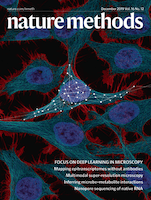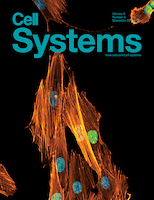
NATURE METHODS
Scope & Guideline
Pioneering innovative techniques in biological research.
Introduction
Aims and Scopes
- Innovative Imaging Techniques:
The journal highlights cutting-edge imaging methods, such as super-resolution microscopy and light-sheet imaging, which facilitate detailed visualization of cellular structures and dynamics. - Single-Cell Analysis:
A core focus on methodologies for single-cell analysis, including single-cell RNA sequencing and proteomics, allows for the dissection of cellular heterogeneity and understanding of complex biological systems. - Computational Biology and Bioinformatics:
There is a strong emphasis on computational methods that enhance data analysis, model biological processes, and integrate large datasets, reflecting the growing importance of bioinformatics in modern biological research. - Genomic and Epigenomic Technologies:
The journal publishes work on new genomic editing techniques, including CRISPR technologies and methods for studying epigenetic modifications, which are vital for understanding gene regulation and cellular function. - Cross-Disciplinary Approaches:
NATURE METHODS encourages interdisciplinary research that combines biology with engineering, physics, and computational science, fostering innovation in experimental design and analysis.
Trending and Emerging
- Artificial Intelligence in Biology:
The integration of AI in biological research is rapidly growing, with methodologies for automating data analysis, enhancing imaging techniques, and predicting biological interactions becoming more prevalent. - Spatial Omics Technologies:
Emerging spatial omics methods that combine transcriptomics and proteomics are gaining traction, enabling researchers to study the spatial context of molecular interactions within tissues. - Gene Editing Innovations:
The advancement of editing technologies, particularly CRISPR and its derivatives, is a significant trend, with ongoing developments in precision and efficiency for targeted modifications in various organisms. - High-Throughput and Single-Cell Approaches:
There is a clear trend towards high-throughput methodologies, especially in single-cell sequencing and proteomics, facilitating a deeper understanding of cellular diversity and function. - Integrative Multi-Omics Approaches:
Combining genomic, transcriptomic, proteomic, and metabolomic data to provide a comprehensive view of biological systems is an emerging theme that reflects the complexity of biological processes.
Declining or Waning
- Traditional Histology Techniques:
Standard histological techniques have become less prominent as newer imaging methods, such as multiplexed tissue imaging and spatial transcriptomics, provide more detailed insights into tissue architecture. - Basic Biochemical Assays:
Traditional biochemical assays are being overshadowed by high-throughput and more complex approaches that allow for comprehensive profiling of cellular activities, reducing the frequency of basic assay publications. - Conventional Microscopy Techniques:
There is a noticeable decline in the publication of papers focused on conventional microscopy as researchers increasingly adopt advanced imaging techniques that offer higher resolution and more functional insights.
Similar Journals

JOURNAL OF MUSCLE RESEARCH AND CELL MOTILITY
Unraveling the Complexities of Muscle Function and MobilityJOURNAL OF MUSCLE RESEARCH AND CELL MOTILITY, published by Springer, is a premier journal dedicated to advancing our understanding of muscle biology and cellular motility. With an ISSN of 0142-4319 and an E-ISSN of 1573-2657, this journal stands out in the fields of biochemistry, cell biology, and physiology, proudly holding a Q2 ranking in each of these categories as per 2023 metrics. Covering significant developments from its inception in 1963 to its anticipated contributions through 2024, this journal serves as a vital platform for researchers and professionals to disseminate their findings and insights globally. Although it does not currently offer open access, its robust academic rigor and relevance are evident from its Scopus rankings, making it a crucial resource for those invested in the biological sciences. With a focus on original research articles, reviews, and methodological advancements, the journal fosters innovative collaborations and discussions within the scientific community, making it an invaluable addition to any researcher’s library.

BIOLOGICAL PROCEDURES ONLINE
Unlocking Innovations in Biochemistry and Genetics.BIOLOGICAL PROCEDURES ONLINE is a premier open-access journal published by BMC, dedicated to advancing the fields of biochemistry, genetics, and molecular biology. With its electronic ISSN 1480-9222 and a strong commitment to accessibility since 2009, this journal provides a vital platform for researchers and scholars to disseminate their findings and foster collaboration within the scientific community. Based in the United Kingdom, this journal has garnered an impressive reputation, achieving Q1 status in the 2023 category rankings, with notable inclusion in the Scopus rankings, placing it in the 86th percentile among 221 peer journals in the general biochemistry, genetics, and molecular biology domain. It covers a broad range of topics, ensuring coverage of the latest advancements and methodologies in biological procedures, making it an essential resource for academics, practitioners, and students alike. Researchers are encouraged to submit their innovative work and contribute to the ongoing dialogue in this dynamic and ever-evolving field.

CELLULAR & MOLECULAR BIOLOGY LETTERS
Advancing the Frontiers of Cellular and Molecular ScienceCELLULAR & MOLECULAR BIOLOGY LETTERS, published by BMC, is a premier open-access journal dedicated to disseminating high-quality research in the fields of Biochemistry, Cell Biology, and Molecular Biology. Established in 1996, the journal has emerged as a leader in its domain, boasting an impressive Q1 ranking across three critical categories as of 2023, reflecting its significant impact within the scientific community. With an ISSN of 1425-8153 and an E-ISSN of 1689-1392, it offers accessible research findings to a global audience, having been open access since 2013. Situated in the United Kingdom, at CAMPUS, 4 CRINAN ST, LONDON N1 9XW, the journal continues to serve as a vital resource for researchers, professionals, and students, contributing to advancements in the understanding of cellular and molecular processes. By providing a platform for original research, reviews, and short communications, CELLULAR & MOLECULAR BIOLOGY LETTERS plays a crucial role in fostering dialogue and collaboration within the scientific community.

Cells, published by MDPI in Switzerland, is a leading open-access journal that has been disseminating groundbreaking research in the fields of Biochemistry, Genetics, and Molecular Biology since its inception in 2011. With an impressive E-ISSN of 2073-4409, the journal boasts a strong impact factor and ranks in the 84th percentile for Scopus ratings, underscoring its significance in advancing scientific knowledge. As a Q1-ranked journal in both 2023 and 2020, it serves as a premier platform for researchers, professionals, and students eager to explore innovative findings and methodologies. By providing unrestricted access to high-quality research, Cells plays a pivotal role in facilitating collaboration and inspiration within the global scientific community, making it an indispensable resource for anyone interested in cutting-edge discoveries in cellular biology.

Cell Reports Methods
Fostering Collaboration Through Rigorous Experimental InsightsCell Reports Methods is a cutting-edge journal published by CELL PRESS, focusing on innovative methodologies in the vast fields of biochemistry, genetics, biotechnology, and radiological sciences. Launched in 2021, it has rapidly ascended to attain a Q1 ranking across multiple disciplines in the latest 2023 metrics, reflecting its influential contribution to the scientific community. With an emphasis on practical and rigorous experimental approaches, this journal serves as a vital resource for researchers looking to advance their methodologies and collaborate on significant findings in their respective specialties. Despite not being an open-access publication, Cell Reports Methods ensures broad accessibility through institutional subscriptions, allowing researchers from various backgrounds to engage with high-quality scholarly work. The journal presents a unique platform for sharing insights from interdisciplinary methods that foster innovation and discovery, ultimately shaping the future of scientific research.

CELL STRUCTURE AND FUNCTION
Illuminating the Complex World of CellsCELL STRUCTURE AND FUNCTION is a distinguished open-access journal published by the Japan Society for Cell Biology, dedicated to advancing the field of cell biology and related disciplines. Since its inception in 1975, and now with open access available since 2017, the journal seeks to disseminate cutting-edge research and reviews that delve into the complexities of cellular structures and their functions. With a notable presence in various categories—ranked Q3 in Cell Biology and Molecular Biology and Q2 in Medicine (Miscellaneous) and Physiology as of 2023—this journal caters to a global audience of researchers, professionals, and students who are keen to explore the latest findings in cellular research. The efforts to foster accessibility and promote scholarly exchange in the field make CELL STRUCTURE AND FUNCTION an essential resource for those looking to stay at the forefront of biological sciences. The journal is indexed in Scopus, marking its relevance and reliability in the academic community. Explore the vast potential of cell biology through this comprehensive platform.

Cell Systems
Pioneering Discoveries in Systems BiologyCell Systems is an esteemed journal published by CELL PRESS, dedicated to advancing the field of systems biology and its applications in cell biology, histology, and pathology. Since its inception in 2015, it has quickly ascended to a prominent position within the academic community, currently holding a Q1 ranking across multiple categories including Cell Biology, Histology, and Pathology and Forensic Medicine for 2023. With an impressive Scopus ranking—third in Medicine: Pathology and Forensic Medicine, and similarly high standing in Histology—it serves as a key resource for researchers and professionals aiming to explore and disseminate cutting-edge research findings. The journal provides an open-access platform, making it an accessible source of knowledge for students and scholars alike, fostering collaboration and innovation within the dynamic landscape of cellular research. With a commitment to high-quality and impactful publications, Cell Systems plays a pivotal role in shaping the future of biological sciences.

BIOLOGY OF THE CELL
Advancing cellular insights for a healthier tomorrow.BIOLOGY OF THE CELL is a prominent academic journal published by Wiley, dedicated to advancing the field of cellular biology through the dissemination of innovative research and insights. With its ISSN (0248-4900) and E-ISSN (1768-322X), this journal has been a vital resource since its inception in 1981 and is set to continue its scholarly contributions until 2024. Positioned within the Q3 quartile in Cell Biology and Q2 in Medicine (miscellaneous) as of 2023, BIOLOGY OF THE CELL is recognized for its rigorous peer-review process and its commitment to high-quality publication in critical areas such as biochemistry, genetics, and molecular biology. Although the journal does not currently offer open access options, it remains accessible through the Wiley platform, ensuring that researchers, professionals, and students can benefit from its rich repository of knowledge. By linking fundamental cellular processes with broader medical implications, this journal serves as a critical platform for fostering dialogue and innovation in cellular research, making it an essential read for anyone engaged in the life sciences.

EMBO REPORTS
Fostering Knowledge in the Heart of Molecular ScienceEMBO REPORTS, published by WILEY, is a premier journal in the fields of Biochemistry, Genetics, and Molecular Biology, recognized for its rigorous peer-review process and impactful scientific contributions. Established in the year 2000 in the United Kingdom, this journal has maintained a stellar reputation, reflected in its consistent positioning within the Q1 category across these disciplines as of 2023. EMBO REPORTS excels in disseminating high-quality and timely research that addresses fundamental questions and challenges in molecular biology and genetics, making it an invaluable resource for researchers, professionals, and students. With impressive Scopus rankings, including Genetics at the 32nd rank and a 90th percentile placement, it fosters an environment for scholarly exchange and advances in knowledge. While Open Access options are not available, the journal continues to enhance its impact through traditional subscription models, thereby maintaining wide visibility in the scientific community. Its ongoing evolution promises continued relevance and influence until at least 2024.

HISTOCHEMISTRY AND CELL BIOLOGY
Elevating Research Standards in Cell BiologyHISTOCHEMISTRY AND CELL BIOLOGY, published by SPRINGER, is a prominent journal dedicated to advancing the fields of histochemistry and cell biology. With an ISSN of 0948-6143 and an E-ISSN of 1432-119X, this journal has carved a significant niche since its inception in 1995, striving for excellence in research dissemination through a rigorous peer-review process. The journal's impact is reflected in its strong performance across various academic categories, achieving a Q1 ranking in Medical Laboratory Technology, Q2 in Histology, and maintaining a credible presence in Cell and Molecular Biology. Nestled in Germany, and with the backing of a reputable publisher, HISTOCHEMISTRY AND CELL BIOLOGY serves as a pivotal platform for researchers, professionals, and students, fostering innovations that push the boundaries of our understanding of cellular processes. While the journal is not open access, it offers subscription-based access options ensuring comprehensive coverage of crucial findings in the rapidly evolving arena of cell biology and histochemistry.